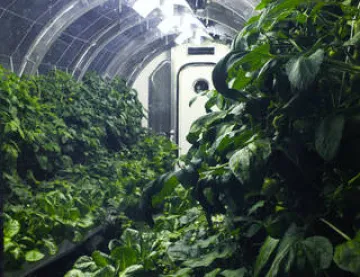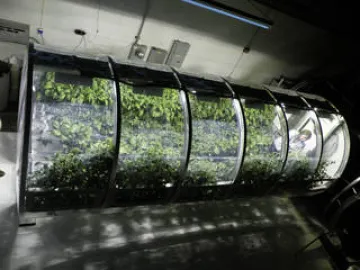Prototype Lunar/Mars Greenhouse
Lunar, Martian Greenhouses Designed to Mimic Those on Earth

Through the design and construction of an innovative hydroponic plant growth chamber, the Prototype Lunar Greenhouse is designed to sustain a continuous vegetarian diet for astronauts on distant locations such as the moon or Mars. It employs plants and crop production designed to provide not only food, but air revitalization, water recycling and waste recycling.
While astronauts have successfully grown plants and vegetables aboard the International Space Station, NASA scientists at the Kennedy Space Center in Florida are collaborating with a university team to develop long-term methods that could help sustain pioneers working in deep space.
Agency researchers believe while there are many challenges for human exploration beyond Earth, they are convinced there are solutions. According to Dr. Ray Wheeler, lead scientist in Kennedy Advanced Life Support Research, the Prototype Lunar/Mars Greenhouse project will support ongoing research in space to grow vegetables for food and cultivating plants to sustain life support systems.
"We're working with a team of scientists, engineers and small businesses at the University of Arizona to develop a closed-loop system," he said. "The approach uses plants to scrub carbon dioxide while providing food and oxygen."
The prototype involves an inflatable, deployable greenhouse to support plant and crop production for nutrition, air revitalization, water recycling, and waste recycling. The process is called a bioregenerative life support system.
Wheeler noted astronauts exhale carbon dioxide, which is then introduced into the greenhouse, and the plants then generate oxygen through photosynthesis. The water cycle begins with water that is brought along or found at the lunar or Martian landing site. Water is oxygenated, given nutrient salts, and it continuously flows across the root zone of the plants and returned to the storage system.
Back on Earth at the University of Arizona in Tucson, tests involving the Prototype Lunar Greenhouse have included determining what plants, seeds or
other materials should be taken along to make the system work on the moon or Mars.
Learning what to take and what to gather on-site will be crucial for living in distant locations. Using available resources located or grown on-site is a practice is called in-situ resource utilization, or ISRU.
NASA scientists and engineers are developing systems to harness resources such as water that should be available in certain areas of the lunar or Martian surface to support missions lasting for months or years.
"We're mimicking what the plants would have if they were on Earth and make use of these processes for life support," said Dr. Gene Giacomelli, director of the Controlled Environment Agriculture Center at the University of Arizona. "The entire system of the lunar greenhouse does represent, in a small way, the biological systems that are here on Earth."

At the University of Arizona's Controlled Environment Agriculture Center, an 18 foot long, 7 foot, 3 inch diameter lunar greenhouse chamber is equipped as a prototype bioregenerative life support system.
A professor in the University of Arizona's Agricultural and Biosystems Engineering Department, Giacomelli explains the next big step is to use additional lunar greenhouse units for specialized testing to ensure the system being developed will adequately support a crew of astronauts working on the moon or Mars.
"We will develop computer models to simulate what we're doing to automatically control the environment and provide a constant level of oxygen," he said.
Additionally, Dr. Roberto Furfaro at the University of Arizona is the principal investigator for the current phase of the project. He is a professor in the Systems and Industrial Engineering Department within the College of Engineering and the director of the Space Systems Engineering Laboratory (SSEL).
The prototypes now being developed are cylindrical -- 18 feet long and more than 8 feet in diameter and were built by Sadler Machine Company, one of the project partners.
To protect from radiation in space, the greenhouse units would likely be buried under surface soil or regolith thus requiring specialized lighting.
"We've been successful in using electric LED (light-emitting diode) lighting to grow plants," Wheeler said. "We also have tested hybrids using both natural and artificial lighting."
Solar light could be captured with light concentrators that track the sun and then convey the light to the chamber using fiber optic bundles.
While studies in working on the surface of other locations in the solar system take place on Earth, aboard the space station astronauts have been gaining experience in growing crops in space.
NASA’s Veggie Plant Growth System was the first American-built, fresh-food growth experiment on the station. It helped continue research for the development of food production systems for long-duration exploration missions. This work is part of Kennedy's efforts in plant research and production of food for exploration missions as directed by the Human Research Project and the Space Life Physical Science Division.
From Earth, Wheeler sees the greenhouse system as a way to take some native processes for sustaining life during exploration beyond Earth.
"I think it's interesting to consider that we're taking our terrestrial companions with us," he said. "While there may be ways to engineer around it in terms of storage and resupply, it wouldn't be as sustainable. The greenhouses provide a more autonomous approach to long-term exploration on the moon, Mars, and beyond."

